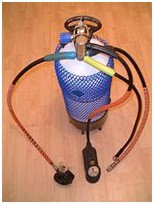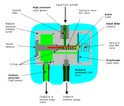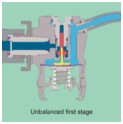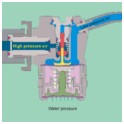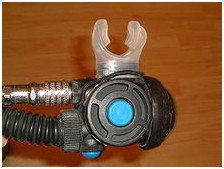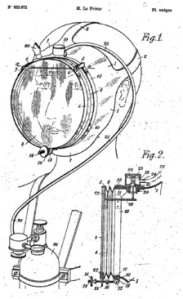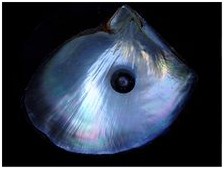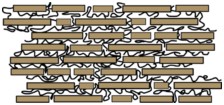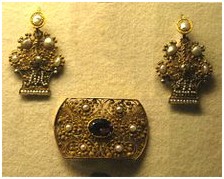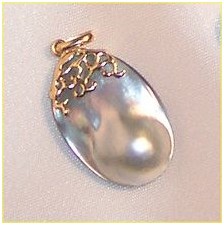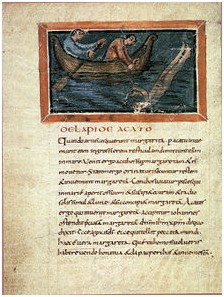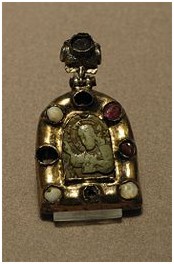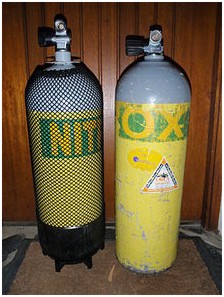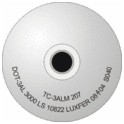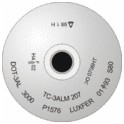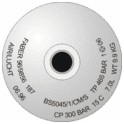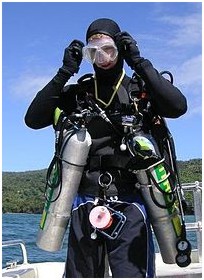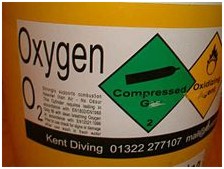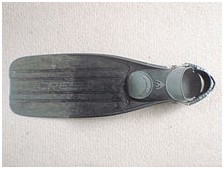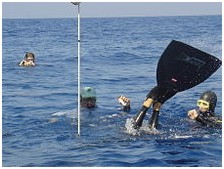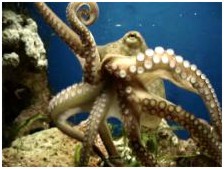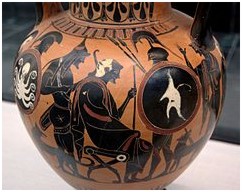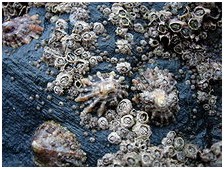Home » 2013
Yearly Archives: 2013
DIVING REGULATOR
- On November 14, 1838, Dr. Manuel Théodore Guillaumet of Argentan, Normandy, France, filed a patent for a twinhose demand regulator; the diver was provided air through pipes from the surface. The apparatus was demonstrated to, and investigated by, a committee of the French Academy of Sciences: “Mèchanique appliquée — Rapport sur une cloche à plongeur inventée par M. Guillaumet” (Applied mechanics — Report on a diving bell invented by Mr. Guillaumet), Comptes rendus, vol. 9, pages 363-366 (September 16, 1839).
- Illustration of diving apparatus invented by Dr. Manuel Théodore Guillaumet from: Alain Perrier, 250 Réponses aux questions du plongeur curieux [250 Answers to the questions of the curious diver] (Aix-en-Provence, France: Éditions du Gerfaut, 2008), page 45.
- On June 19, 1838, in London, England, a Mr. William Edward Newton first filed a patent (no. 7695: “Diving apparatus”) for a diaphram-actuated, twin-hose demand valve for divers. (See: John Bevan (1990) “The First Demand Valve?,” SPUMS Journal [SPUMS = South Pacific Underwater Medicine Society], vol. 20, no. 4, pages 239-240.) However, it is believed that Mr. Newton was merely filing a patent on behalf of Dr. Guillaumet. (See: le scaphandre autonome (scuba diving): Un brevet semblable est déposé en 1838 par William Newton en Angleterre. Il y a tout lieu de penser que Guillaumet, devant les longs délais de dépôt des brevets en France, a demandé à Newton de faire enregistrer son brevet en Angleterre où la procédure est plus rapide, tout en s’assurant les droits exclusifs d’exploitation sur le brevet déposé par Newton. (A similar patent was filed in 1838 by William Newton in England. There is every reason to think that owing to the long delays in filing patents in France, Guillaumet asked Newton to register his patent in England where the procedure was faster, while ensuring the exclusive rights to exploit the patent filed by Newton. [Note: The illustration of the apparatus in Newton’s patent application is identical to that in Guillaumet’s patent application; furthermore, Mr. Newton was apparently an employee of the British Office for Patents, who applied for patents on behalf of foreign applicants.]
Also from “le scaphandre autonome” Web site: Reconstruit au XXe siècle par les Américains, ce détendeur fonctionne parfaitement, mais, si sa réalisation fut sans doute effective au XIXe, les essais programmés par la Marine Nationale ne furent jamais réalisés et l’appareil jamais commercialisé. (Reconstructed in twentieth century by the Americans, this regulator worked perfectly; however, although it was undoubtedly effective in the nineteenth century, the test programs by the French Navy were never conducted and the apparatus was never sold.))
A “single-hose” aqualung with the first stage on top of the cylinder and the second stage demand valve on the left hand hose
- “Ohgushi’s Peerless Respirator”. The valve was operated by the diver’s teeth.
- Commandant le Prieur’s breathing sets: see Timeline of underwater technology. They were used for some sport diving on the French Riviera.
- Several versions of the Le Prieur breathing set. Yves Le Prieur first patented with Maurice Fernez, in 1926, a breathing apparatus using a mouthpiece, but as of 1933 he removed the mouthpiece and included a circular full-face mask in all following patents (like 1937, 1946 or 1947).
- In 1934 René Commeinhes, from Alsace (France), adapted a Rouquayrol-Denayrouze apparatus for the use of firefighters. With new 1937 and 1942 patents (GC37 and GC42) his son Georges adapted this invention to underwater breathing by means of a single hose connected to a full-face mask.
- Captain Trevor Hampton invented independently from Le Prieur a similar regulator-mask in the 1950s and submitted it for patent. The Royal Navy requisitioned the patent, but found no use for it and eventually released it. By then, the market had moved on and it was too late to make this regulator-mask in bulk for sale.
- Air Liquide: La Spirotechnique, Apeks and Aqua Lung
- Apollo Sports
- Atomic Aquatics
- Beuchat
- Cressi-Sub
- Dive Rite
- Draeger
- HTM Sports: Dacor and Mares
- Poseidon
- ROMI Enterprises: Aeris and Oceanic
- Ocean Divers Supply
- Scubapro
- Tusa
- Zeagle
- Edge-HOG (Highly Optimized Gear)
- Swagelok Speciality Regulators {Breathing Air}
- Dive Rite
- Coltri
- Edge-HOG
- Genesis
- Halcyon
- OMS
- Seacsub
- Sherwood
- Tigullio
- XS Scuba
PEARL
London, Victoria and Albert Museum
Saint Petersburg, Hermitage Museum
DIVING CYLINDER
- Taper thread (17E), with a 12% taper right hand thread, standard Whitworth 55° form with a pitch of 14 threads per inch and pitch diameter at the top thread of the cylinder of 18.036mm. These connections are sealed using thread tape and torqued to between 120 and 150 N.m on steel cylinders, and 75 to 140 N.m on aluminium cylinders
- M25x2 parallel thread, which is sealed by an O-ring and torqued to 100 to 130 N.m on steel, and 95 to 130 N.m on aluminium cylinders
- M18x1.5 parallel thread, which is sealed by an O-ring, and torqued to 100 to 130 N.m on steel cylinders, and 85 to 100 N.m on aluminium cylinders
- 3/4″x14 BSP parallel thread. This has a 55° Whitworth thread form, a pitch diameter of 25.279mm and a pitch of 14 threads per inch (1,814mm)
- 3/4″x14 NGS (NPSM)parallel thread, sealed by an O-ring, torqued to 40 to 50 ft.lbf on aluminium cylinders This has a 60° thread form, a pitch diameter of 0.9820″ to 0.9873″, and a pitch of 14 threads per inch.
- 3/4″x16 UNF, sealed by an O-ring, torqued to 40 to 50 ft.lbf on aluminium cylinders
- the pillar valve or cylinder valve is the point at which the pressure vessel connects to the diving regulator. The purpose of the pillar valve is to control gas flow to and from the pressure vessel and to form a seal with the regulator. Some countries require that the pillar valve includes a burst disk, a type of pressure ‘fuse’, that will fail before the pressure vessel fails in the event of overpressurization.
- a rubber o-ring forms a seal between the metal of the pillar valve and the metal of the diving regulator. Fluoroelastomer (i.e. “viton”) o-rings are used with cylinders storing oxygen-rich gas mixtures to reduce the risk of fire.
- A-clamp or yoke – the connection on the regulator surrounds the valve pillar and presses the output O-ring of the pillar valve against the input seat of the regulator. The yoke is screwed down snug by hand (overtightening can make the yoke impossible to remove later without tools) and the seal is created by pressure when the valve is opened. This type is simple, cheap and very widely used worldwide. It has a maximum pressure rating of 232 bar and the weakest part of the seal, the O-ring, is not well protected from overpressurisation.
- 232 bar DIN (5-thread, G5/8) – the regulator screws into the cylinder valve trapping the O-ring securely. These are more reliable than A-clamps because the O-ring is well protected, but many countries do not use DIN fittings widely on compressors, or cylinders which have DIN fittings, so a European diver with a DIN system abroad in many places will need to take an adaptor.
- 300 bar DIN (7-thread, G5/8) – these are similar to 5-thread DIN fitting but are rated to 300 bar working pressures. The 300 bar pressures are common in European diving and in US cave diving, but their acceptance in U.S. sport diving has been hampered by the fact that United States Department of Transportation rules presently prohibit the transport of metal scuba cylinders on public roads with pressures above about 230 bar, even if the cylinders and air delivery systems have been rated for these pressures by the American agencies which oversee cylinder testing and equipment compatibility for SCUBA (Occupational Safety and Health Administration and Compressed Gas Association).
- The new European Norm EN 144-3:2003 introduced a new type of valve, similar to existing 232 bar or 300 bar DIN valves, however, with a metric M 26×2 fitting on both the cylinder and the regulator. These are to be used for breathing gas with oxygen content above that normally found in natural air in the Earth’s atmosphere (i.e. 22–100%). From August 2008, these shall be required for all diving equipment used with nitrox or pure oxygen. The idea behind this new standard is to prevent a rich mixture being filled to a cylinder that is not oxygen clean. However even with use of the new system there still remains nothing except human procedural care to ensure that a cylinder with a new valve remains oxygen-clean – which is exactly how the current system works.
- A male thread cylinder valve was supplied with some Dräger semi-closed circuit recreational rebreathers (Dräger Ray) for use with nitrox mixtures.
- The most commonly used cylinder valve type is the single outlet plain valve, sometimes known as a “K” valve, which allows connection of a single regulator, and has no reserve function. It simply opens to allow gas flow, or closes to shut it off. Several configurations are used, with options of DIN or A-clamp connection, and vertical or transverse spindle arrangements. The valve is operated by turning a knob, usually rubber or plastic, which affords a comfortable grip. Several turns are required to fully open the valves. Some DIN valves are convertible to A-clamp by use of an insert which is screwed into the opening.
- Y and H cylinder valves have two outlets, each with its own valve, allowing two regulators to be connected to the cylinder. If one regulator “freeflows”, which is a common failure mode, or ices up, which can happen in water below about 5°C, its valve can be closed and the cylinder breathed from the regulator connected to the other valve. The difference between an H valve and a Y valve is that the Y valve body splits into two posts roughly 90° to each other and 45° from the vertical axis, looking like a Y, while an H valve is usually assembled from a valve designed as part of a manifold system with an additional valve post connected to the manifold socket, with the valve posts parallel and vertical, which looks a bit like an H. Y-valves are aso known as “slingshot valves” due to their appearance.
- Reserve lever or “J-valve” (obsolescent). Until the 1970s, when submersible pressure gauges on regulators came into common use, diving cylinders often used a mechanical reserve mechanism to indicate to the diver that the cylinder was nearly empty. The gas supply was automatically cut-off when the gas pressure reached the reserve pressure. To release the reserve, the diver pulled down on a rod that ran along the side of the cylinder and which activated a lever on the valve. The diver would then finish the dive before the reserve (typically 300 pounds per square inch (21 bar)) was consumed. On occasion, divers would inadvertently trigger the mechanism while donning gear or performing a movement underwater and, not realizing that the reserve had already been accessed, could find themselves out of air at depth with no warning whatsoever. The J-valve got its name from being item number J in one of the first scuba equipment manufacturer catalogs. The standard non-reserve yoke valve at the time was item K, and is often still referred to as a K-valve. J-valves are still occasionally used by professional divers in zero visibility, where the SPG can not be read.
- Less common in the 1950s thru 1970s was an R-valve which was equipped with a restriction that caused breathing to become difficult as the cylinder neared exhaustion, but that would allow less restricted breathing if the diver began to ascend and the ambient water pressure lessened, providing a larger pressure differential over the orifice. It was never particularly popular because, were it necessary for the diver to descend (as is often necessary in cave and wreck diving, breathing would become progressively more difficult as the diver went deeper, eventually becoming impossible until the diver could begin his or her ascent.
- The earliest type is a tube with a connector on each end which is attached to the cylinder valve outlet, and an outlet connection in the middle, to which the regulator is attached. A variation on this pattern includes a reserve valve at the outlet connector. The cylinders are isolated from the manifold when closed, and the manifold can be attached or disconnected while the cylinders are pressurised.
- More recently, manifolds have become available which connect the cylinders on the cylinder side of the valve, leaving the outlet connection of the cylinder valve available for connection of a regulator. This means that the connection cannot be made or broken while the cylinders are pressurised, as there is no valve to isolate the manifold from the interior of the cylinder. This apparent inconvenience allows a regulator to be connected to each cylinder, and isolated from the internal pressure independently, which allows a malfunctioning regulator on one cylinder to be isolated while still allowing the regulator on the other cylinder access to all the gas in both cylinders.
- These manifolds may be plain or may include an isolation valve in the manifold, which allows the contents of the cylinders to be isolated from each other. This allows the contents of one cylinder to be isolated and secured for the diver if a leak at the cylinder neck thread, manifold connection, or burst disk on the other cylinder causes its contents to be lost.
- Volume in litres
- Weight in kilograms
- Pressure in bar.
- “travel gas” is used during the descent and ascent. It is typically air or nitrox with an oxygen content between 21% and 40%. Travel gas is needed when the bottom gas is hypoxic and therefore is unsafe to breathe in shallow water.
- “bottom gas” is only breathed at depth. It is typically a helium-based gas which is low in oxygen (below 21%) or hypoxic (below 17%).
- “deco gas” is used at the decompression stops and is generally a nitrox with a high oxygen content, or pure oxygen, to accelerate decompression.
- a “stage” is a cylinder holding reserve, travel or deco gas. They are usually carried “side slung”, clipped on either side of the diver to the harness of the backplate and wing or buoyancy compensator, rather than on the back. Commonly divers use aluminium stage cylinders because they are nearly neutrally buoyant in water and can be removed underwater with less effect on the diver’s overall buoyancy.
- oxygen rebreathers have an oxygen cylinder
- semi-closed circuit rebreathers have a cylinder which usually contains nitrox or a helium based gas.
- closed circuit rebreathers have an oxygen cylinder and a “diluent” cylinder, which contains air, nitrox or a helium based gas
- Single cylinder or single aqualung: consists of a single large cylinder with one first-stage regulator, and usually two secondary regulator/mouthpieces. This configuration is simple and cheap but it is only a single system: it has no redundancy in case of failure. If the cylinder or first-stage regulator fails, the diver is totally out of air and faces an emergency. All training agencies train divers to rely on a buddy to assist them in this situation. The skill of gas sharing is required at the most basic scuba course. This equipment configuration, although common with entry-level divers and for most sport diving, is not recommended for any dive that is deeper than 30 m (100 ft) or where decompression stops are needed, or where there is an overhead environment (wreck diving, cave diving, or ice diving). Generally, these conditions, because they prevent immediate emergency ascent, may define technical diving.
- Single cylinder with dual regulators: consists of a single large cylinder with two first-stage regulators, each with a second stage regulator/mouthpiece. This system is used for recreational diving where cold water makes redundancy required. It is common in continental Europe, especially Germany. The advantage is that a regulator failure can be solved underwater to bring the dive to a controlled conclusion without buddy breathing or gas sharing. However, it is hard to reach the valves, so there is some reliance on the dive buddy to help close the valves of the free-flowing regulator quickly.
- Main cylinder plus a small independent cylinder: this configuration uses a larger, main cylinder along with an independent smaller cylinder, often called a “pony”. The diver has two independent systems, but the total ‘breathing system’ is now heavier, more expensive to buy and maintain.
- The pony is typically a 2 to 5 litre cylinder. Its capacity determines the depth of dive and decompression duration for which it provides protection. Ponies are generally fixed to the diver’s buoyancy compensator (BC) or main cylinder behind the diver’s back. They can also be clipped to the BC at the diver’s side or chest. Ponies provided an acceptable emergency supply but are only useful if the diver trains to bail out, i.e. to use one.
- Another type of separate small air source is a hand-held cylinder filled with about 85 litres (0.279 ft) of free air with a diving regulator directly attached, such as the Spare Air. This source provides only a few breaths of gas at depth and is mainly suitable as a shallow water bailout.
- Independent twin set /doubles: this consists of two independent cylinders and two regulators. This system is heavier, more expensive to buy and maintain and more expensive to fill. Also the diver must swap demand valves during dive to preserve a safety reserve of air in each cylinder. If this is not done, then should a cylinder fail the diver may end up having no reserve. Independent twin sets do not work well with air-integrated computers – as they usually only monitor one cylinder. Many divers feel the complexity of switching regulators periodically to ensure both cylinders are evenly used is offset by the redundancy of two entirely separate breathing supplies. These will normally be mounted as a twin set on the diver’s back, but alternatively can be carried in a sidemount configuration where penetration of wrecks or caves requires it.
- Manifolded twin set /doubles with a single regulator: two cylinders are joined at their pillar valves with a manifold but only one regulator is attached to the system. This makes it simple and cheap but means there is no redundant breathing system, only a double gas supply.
- Manifolded twin set /doubles with two regulators: consist of two cylinders with their pillar valves joined with a manifold, with a valve that can isolate the two pillar valves. In the event of a problem with one cylinder the diver may close the isolator valve to preserve gas in the cylinder which has not failed. The pros of this configuration include a large gas supply, no requirement to change regulators underwater, automatic gas supply management, and in most failure situations the diver may close a failed valve or isolate a cylinder in order to leave himself with an emergency supply. On the down side the manifold is another potential point of failure, and there is a danger of losing all air if the manifold valve cannot be closed when a problem occurs. This configuration of cylinders is often used in Technical diving.
- Sling bottles/cylinders: are a configuration of independent cylinder used for technical diving. They are independent cylinders with their own regulators and are carried clipped to the harness at the side of the diver. Their purpose may be to carry either stage, travel, decompression, or bailout gas while the back mounted cylinder(s) carry bottom gas. Stage cylinders carry gas to extend bottom time, travel gas is used to reach a depth where bottom gas may be safely used if it is hypoxic at the surface, and decompression gas is gas intended to be used during decompression to accelerate the elimination of inert gases. Bailout gas is an emergency supply intended to be used to surface if the main gas supply is lost.
- Side mount cylinders: are sling cylinders mounted at the diver’s side which carry bottom gas when the diver does not carry back mount cylinders. They may be used in conjunction with other sling cylinders where necessary.
- As part of the rebreather itself. The rebreather must have at least one source of fresh gas stored in a cylinder; many have two and some have more cylinders. Due to the lower gas consumption of rebreathers, these cylinders typically are smaller than those used for equivalent open-circuit dives. See the main article: rebreather.
- In a bail out system: rebreather divers often carry one or more redundant gas sources should the rebreather fail:
- Open-circuit: a simple diving cylinder and regulator. The number of open-circuit bail outs, their capacity and the breathing gases they contain depend on the depth and decompression needs of the dive. So on a deep, technical rebreather dive, the diver will need a bail out “bottom” gas and a bail out “decompression” gas for use. On such a dive, it is the capacity and duration of the bail out that limits the depth and duration of the dive – not the capacity of the rebreather.
- Closed-circuit: a rebreather containing a diving cylinder and regulator. Using another rebreather as a bail out is possible but uncommon. Although the long duration of rebreathers seems compelling for a bail out, rebreathers are relatively bulky, complex, vulnerable to damage and require more time to start breathing from, than easy-to-use, instantly available, robust and reliable open-circuit equipment.
- working gas pressure : this normally ranges between 200 and 300 bars (2,900 and 4,400 psi)
- internal volume : this normally ranges between 3 litres and 18 litres
- breathing rate or respiratory minute volume (RMV) of the diver. In normal conditions this will be between 10 and 25 litres per minute (L/min) for recreational divers who are not working hard. At times of extreme high work rate, breathing rates can rise to 95 L/min. In the UK, a working breathing rate of 40 litres per minute is used for commercial diving, whilst a figure of 50 litres per minute is used for emergencies. (The Association of Diving Contractors)
- time
- ambient pressure: the depth of the dive determines this. The ambient pressure at the surface is 1 bar (15 psi). For every 10 metres (33 ft) in salt water the diver descends, the pressure increases by 1 bar (15 psi). As a diver goes deeper, the breathing gas is delivered at a pressure equal to ambient water pressure. Thus, it requires twice as much mass of gas to fill the same volume (the diver’s lungs) at 10 metres (33 ft) as it does at the surface, and three times as much at 20 metres (66 ft). If a given cylinder consumed at a constant rate would last a diver one hour at the surface, it would last 30 minutes at 10 metres (33 ft), 20 minutes at 20 metres (66 ft) and just 15 minutes at 30 metres (98 ft).
|
Cylinder
|
Air
|
Weight on land
|
Buoyancy
|
|||||
|
Material
|
Volume
|
Pressure
|
Volume
|
Weight
|
Empty
|
Full
|
Empty
|
Full
|
|
(litre)
|
(bar)
|
(litre)
|
(kg)
|
(kg)
|
(kg)
|
(kg)
|
(kg)
|
|
|
Steel
|
12
|
200
|
2400
|
3.0
|
16.0
|
19.0
|
-1.2
|
-4.3
|
|
15
|
200
|
3000
|
3.8
|
20.0
|
23.8
|
-1.4
|
-5.2
|
|
|
16 (XS 130)
|
230
|
3680
|
4.7
|
19.5
|
23.9
|
-0.9
|
-5.3
|
|
|
2×7
|
200
|
2800
|
3.5
|
19.5
|
23.0
|
-2.0
|
-5.6
|
|
|
8
|
300
|
2400
|
3.0
|
13.0
|
16.0
|
-3.5
|
-6.5
|
|
|
10
|
300
|
3000
|
3.8
|
17.0
|
20.8
|
-4.0
|
-7.8
|
|
|
2×4
|
300
|
2400
|
3.0
|
15.0
|
18.0
|
-4.0
|
-7.0
|
|
|
2×6
|
300
|
3600
|
4.6
|
21.0
|
25.6
|
-5.0
|
-9.6
|
|
|
Aluminium
|
9 (AL 63)
|
203
|
1826
|
2.3
|
12.2
|
13.5
|
+1.8
|
-0.5
|
|
11 (AL 80)
|
203
|
2247
|
2.8
|
14.4
|
17.2
|
+1.8
|
-1.1
|
|
|
13 (AL100)
|
203
|
2584
|
3.2
|
17.1
|
20.3
|
+1.4
|
-1.7
|
|
- oxygen in high concentrations is a major cause of fire and rust.
- oxygen should be very carefully transferred from one cylinder to another and only ever stored in containers that are certified and labeled for oxygen use.
- gas mixtures containing proportions of oxygen other than 21% could be extremely dangerous to divers who are unaware of the proportion of oxygen in them. All cylinders should be labeled with their composition.
- cylinders containing a high oxygen content must be cleaned for the use of oxygen and lubricated with oxygen service grease to reduce the chance of combustion.
- In the United States, a visual inspection is NOT required by the USA DOT every year though they do require a hydrostatic every five years. The visual inspection requirement is a diving industry standard based on observations made during a review by the National Underwater Accident Data Center.
- In European Union countries a visual inspection is required every 2.5 years, and a hydrostatic every five years.
- In Norway a hydrostatic (including a visual inspection) is required 3 years after production date, then every 2 years.
- Legislation in Australia requires that cylinders are hydrostatically tested every twelve months, regardless.
- In South Africa a hydrostatic test is required every 4 years, and visual inspection every year. Eddy current testing of neck threads must be done according to the manufacturer’s recommendations.
- Air has either a white (RAL 9010) top and black (RAL 9005) band on the shoulder, or white (RAL 9010) and black (RAL 9005) “quartered” shoulders.
- Heliox has either a white (RAL 9010) top and brown (RAL 8008) band on the shoulder, or white (RAL 9010) and brown (RAL 8008) “quartered” shoulders.
- Nitrox, like Air, has either a white (RAL 9010) top and black (RAL 9005) band on the shoulder, or white (RAL 9010) and black (RAL 9005) “quartered” shoulders.
- Pure oxygen has a white shoulder (RAL 9010).
- Pure helium has a brown shoulder (RAL 9008).
- Trimix has a white, black and brown segmented shoulder.
- Cylinder colour is Golden yellow with a French grey shoulder.
- Cylinders containing gases other than air or medical oxygen must have a transparent adhesive label stuck on below the shoulder with the word NITROX or TRIMIX in green and the composition of the gas listed.
- Cylinders containing medical oxygen must be black with a white shoulder.
<!– amazon_ad_tag="pacicorn-20"; amazon_ad_width="468"; amazon_ad_height="60"; amazon_color_background="000000"; amazon_color_border="43EDD1"; amazon_color_logo="010320"; amazon_color_text="06F90E"; amazon_color_link="F9081F"; amazon_ad_logo="hide"; amazon_ad_link_target="new"; amazon_ad_border="hide"; amazon_ad_title="Diving Equipment"; //–>
SWIMFINS
|
Cressi-sub vented paddle fin
Beuchat Closed-heel Jetfins
Beuchat Open-heel adjustable Jetfins
Long bladed open heel fin with moderately stiff plastic blade
A freediver using a monofin
|
SNORKEL
DIVING MASK
- The double-dome mask. This was invented by HydroOptix. Double-dome masks allow a wider field of view and avoid the refraction error in perceived distance and size of objects. Underwater the curved mask windows make the diver’s vision effectively more hyperopic, or less myopic, and the diver must wear special contact lenses to compensate (unless his eyes are myopic to the right amount to compensate exactly for the refraction at the curved mask windows). The diver’s vision will become myopic when he puts his head out of water with the contact lenses in.
- The “Data Mask”, developed by Oceanic, is an eyes-and-nose diving mask with a built-in LCD display which displays various dive and breathing set conditions including the function of a diving computer. It is currently very expensive.
- full face diving mask – often worn by working divers who need underwater verbal communication ability.
- diving helmet – often worn by divers using surface supplied diving equipment.
- hard hat – part of the old fashioned standard diving dress.
- fluid filled mask – the need to equilibrate the internal pressure in the mask by exhaling air through the nose reduces the freediver capacity to dive deep. Masks or swimming goggles with high power lenses (40-200 diopters) have been developed in this view: they are filled with water or saline fluid.
OCTOPUS
The octopus inhabits many diverse regions of the ocean, including coral reefs, pelagic waters, and the ocean floor. They have numerous strategies for defending themselves against predators, including the expulsion of ink, the use of camouflage and deimatic displays, their ability to jet quickly through the water, and their ability to hide. An octopus trails its eight arms behind it as it swims. All octopuses are venomous, but only one group, the blue-ringed octopuses, is known to be deadly to humans.
- Class Cephalopoda
- Subclass Nautiloidea: nautilus
- Subclass Coleoidea
- Superorder Decapodiformes: squid, cuttlefish
- Superorder Octopodiformes
- Family †Trachyteuthididae
- Order Vampyromorphida: vampire squid
- Order Octopoda
- Genus †Keuppia
- Genus †Palaeoctopus
- Genus †Paleocirroteuthis
- Genus †Pohlsepia
- Genus †Proteroctopus
- Genus †Styletoctopus
- Suborder Cirrina: finned deep-sea octopus
- Family Opisthoteuthidae: umbrella octopus
- Family Cirroteuthidae
- Family Stauroteuthidae
- Suborder Incirrina
- Family Amphitretidae: telescope octopus
- Family Bolitaenidae: gelatinous octopus
- Family Octopodidae: benthic octopus
- Family Vitreledonellidae: glass octopus
- Superfamily Argonautoida
- Family Alloposidae: seven-arm octopus
- Family Argonautidae: argonauts
- Family Ocythoidae: tuberculate pelagic octopus
- Family Tremoctopodidae: blanket octopus
BARNACLE
- Superorder Acrothoracica Gruvel, 1905
- Order Pygophora Berndt, 1907
- Order Apygophora Berndt, 1907
- Superorder Rhizocephala Müller, 1862
- Order Kentrogonida Delage, 1884
- Order Akentrogonida Häfele, 1911
- Superorder Thoracica Darwin, 1854
- Order Pedunculata Lamarck, 1818
- Order Sessilia Lamarck, 1818
SCUBA DIVING
1: Air Hose, 2: Mouthpiece, 3: Regulator, 4: Harness, 5: Back plate, 6: Tank
|
Type of diving activity
|
Classification
|
|
aquarium maintenance in large public aquariums
|
commercial, scientific
|
|
boat and ship inspection, cleaning and maintenance
|
commercial, naval
|
|
cave diving
|
technical, recreational, scientific
|
|
diver training
|
professional
|
|
fish farm maintenance (aquaculture)
|
commercial
|
|
fishing, e.g. for abalones, crabs, lobsters, scallops, sea crayfish,
|
commercial
|
|
frogman, manned torpedo
|
military
|
|
media diving: making television programs, etc.
|
professional
|
|
mine clearance and bomb disposal, disposing of unexploded ordnance
|
military, naval
|
|
pleasure, leisure, sport
|
recreational
|
|
policing/security: diving to investigate or arrest unauthorized divers
|
police diving, military, naval
|
|
search and recovery diving
|
public safety, police diving
|
|
search and rescue diving
|
police, naval, public service
|
|
spear fishing
|
recreational
|
|
stealthy infiltration
|
military
|
|
surveys and mapping
|
scientific, recreational
|
|
scientific diving (marine biology, oceanography, hydrology, geology, palaeontology, diving physiology and medicine)
|
scientific
|
|
underwater archaeology (shipwrecks; harbors, and buildings)
|
scientific, recreational
|
|
underwater inspections and surveys (occasionally)
|
commercial, military
|
|
underwater photography
|
professional, recreational
|
|
underwater tour guiding
|
professional, recreational
|
|
underwater tourism
|
recreational
|
|
Table of Light Absorption in pure water
|
||
|
Color
|
Average wavelength
|
Approximate depth of total absorption
|
|
Ultraviolet
|
300 nm
|
25 m
|
|
Violet
|
400 nm
|
100 m
|
|
Blue
|
475 nm
|
275 m
|
|
Green
|
525 nm
|
110 m
|
|
Yellow
|
575 nm
|
50 m
|
|
Orange
|
600 nm
|
20 m
|
|
Red
|
685 nm
|
5 m
|
|
Infra-red
|
800 nm
|
3 m
|
|
No.
|
Signal
|
Meaning
|
Comment
|
|
1.
|
Hand raised, fingers pointed up, palm to receiver.
|
STOP
|
Transmitted in the same way as a traffic police officer’s STOP
|
|
2.
|
Thumb extended downward from clenched fist.
|
GO DOWN or GOING DOWN
|
|
|
3.
|
Thumb extended upward from clenched fist.
|
GO UP or GOING UP
|
|
|
4.
|
Thumb and forefinger making a circle with three remaining fingers extended (if possible).
|
OK! or OK?
|
Divers wearing mittens may not be able to extend 3 remaining fingers distinctly.
|
|
5.
|
Two arms extended overhead with finger tips touching above head to make a large O shape.
|
OK! or OK?
|
A diver with only one free arm may make this signal by extending that arm overhead with finger tips touching top of head to make the O shape. Signal is for long-range use.
|
|
6.
|
Hand flat, fingers together, palm down, thumb sticking out, then hand rocking back and forth on axis of forearm.
|
SOMETHING IS WRONG
|
This is the opposite of OK! The signal does not indicate emergency.
|
|
7.
|
Hand waving over head (may also thrash hand on water).
|
DISTRESS
|
Indicates immediate aid required.
|
|
8.
|
Fist pounding on chest.
|
LOW ON AIR
|
Indicates signaler’s air supply is reduced.
|
|
9.
|
Hand slashing or chopping throat.
|
OUT OF AIR
|
Indicates that the signaler cannot breathe.
|
|
10.
|
Clenched fist on arm extended in direction of danger.
|
DANGER
|
- Membrane or Shell drysuits: usually a trilaminate construction; owing to the thinness of the material (around 1 mm), these require an undersuit, usually of high insulation value if diving in cooler water.
- Neoprene drysuits: a similar construction to wetsuits; these are often considerably thicker (7–8 mm) and have sufficient insulation to allow a lighter-weight undersuit (or none at all); however on deeper dives the neoprene can compress to as little as 2 mm thus losing a proportion of its insulation. Compressed or crushed neoprene may also be used (where the neoprene is pre-compressed to 2–3 mm) which avoids the variation of insulating properties with depth. These drysuits function more like a membrane suit.
- Technical diving – diving deeper than 40 metres (130 ft), using mixed gases, and/or entering overhead environments (caves or wrecks)
- Surface supplied diving – use of umbilical gas supply and diving helmets.
- Saturation diving – long-term use of underwater habitats under pressure and a gradual release of pressure over several days in a decompression chamber at the end of a dive.
- American Canadian Underwater Certifications (ACUC) (formerly Association of Canadian Underwater Councils) – originated in Canada in 1969 and expanded internationally in 1984
- British Sub Aqua Club (BSAC) – based in the United Kingdom, founded in 1953 and is the largest dive club in the world
- European Committee of Professional Diving Instructors (CEDIP) based in Europe since 1992
- Confédération Mondiale des Activités Subaquatiques (CMAS), the World Underwater Federation
- National Association of Underwater Instructors (NAUI) – based in the United States
- Professional Diving Instructors Corporation (PDIC) – based in the United States
- Professional Association of Diving Instructors (PADI) – based in the United States, largest recreational dive training and certification organization in the world
- Scottish Sub Aqua Club (SSAC or ScotSAC) the National Governing Body for the sport of diving in Scotland.
- International Training SDI, TDI & ERDi – based in the United States, TDI is the world’s largest technical diving agency, SDI is the recreational division focusing on new methods and online courses, and ERDi is the public safety component.
- Scuba Schools International (SSI) – based in the United States with 35 Regional Centers and Area Offices around the globe.
- YMCA Scuba – based in the United States, provided by Young Men’s Christian Association (YMCA) of the USA; discontinued on 31 December 2008.
SEA URCHINS






